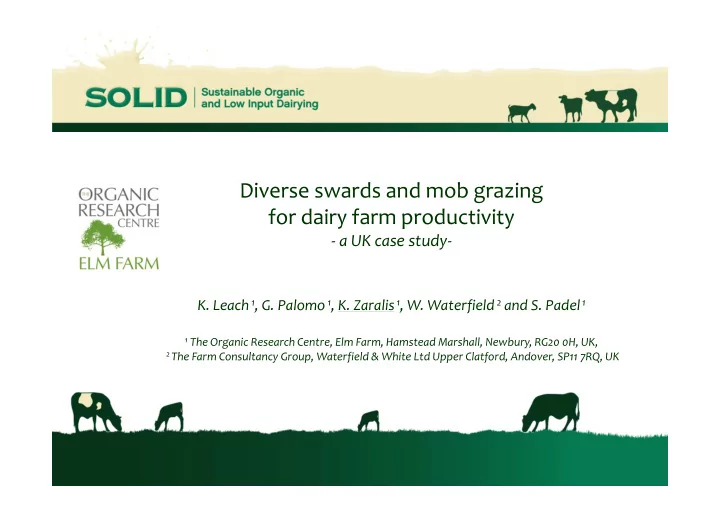

Diverse swards and mob grazing for dairy farm productivity - a UK case study- K. Leach 1 , G. Palomo 1 , K. Zaralis 1 , W. Waterfield 2 and S. Padel 1 1 The Organic Research Centre, Elm Farm, Hamstead Marshall, Newbury, RG20 0H, UK, 2 The Farm Consultancy Group, Waterfield & White Ltd Upper Clatford, Andover, SP11 7RQ, UK
Background • What is Mob Grazing (or Mob stocking) ? – A method of stocking at a high grazing pressure for a short time to remove forage rapidly as a management strategy • Pastures are allowed to grow taller than the traditional height • Animals are allowed to consume and trample the sward • Grass recovery, paying particular consideration to soil quality • Concentrated manure and plant residues contribute to Soil Organic Matter (SOM) and to soil nutrients
Background • What is Mob Grazing (or Mob stocking) ? Pastures are allowed to grow taller than the traditional height • long resting periods Animals consume and trample the sward for a short period of time • are moved to a new paddock within 24h
Background • Mob Grazing (or Mob stocking) Grazing patterns of wild herbivores roaming unrestricted over large rangelands
Background • Mob Grazing (or Mob stocking) Was developed in Africa and North and South America to address problems related to – Over Grazing – Deterioration of natural pastures – Soil erosion and water stress
Background • Claimed benefits of Mob Grazing • Long resting period allow for a greater root biomass • Animals can opt for parts with high nutrient value through diet selection • Trampling the residual plants can increase Soil Carbon levels • Increased SC levels promote water holding capacity of the soil • Improved Soil Structure • High forage yield
Background • Mob Grazing There is little research-based information on the benefits of MG Is this system suitable for cool temperate climates? Does it deliver the claimed benefits?
Participatory Research Study Pictures from the participating farm
Participatory Research Study • Farm information Manor Farm is a 220 ha mixed dairy /arable farm in South West, UK Converted to organic production in 2005 Diverse swards consist of 10 grass species, 6 legumes and 5 herbs Mob grazing was introduced as an approach to increase Soil Organic Matter
Participatory Research Study • Measurements – Assessing Forage Productivity – Determination of herbage composition – Comparison of the productivity between Grass/Clover and Diverse Sward – DM based on the Plate Meter readings will be compared with the actual DM yields (determined in the lab)
Assessing Forage Productivity Grazed paddock Ungrazed paddock
Participatory Research Study • Assessing Forage Productivity Ungrazed paddock Grazed paddock
Participatory Research Study • Assessing Forage Productivity Ungrazed paddock Grazed paddock
Participatory Research Study Senescent Broad leaves Grass Clover
Participatory Research Study
Forage Composition & Productivity (year 1)
Forage Productivity (year 2)
Forage Productivity Total Production (year 1) Total Production (year 2) Plant Species tonnes % Plant Species tonnes % Grass 5.79 56% Grass 7.84 71% Clover 2.61 25% Clover 2.38 22% Broad leaves 1.61 16% Broad leaves 0.65 6% Senescent 0.30 3% Senescent 0.19 2% Total Production 10.3 100% Total Production 11.0 100%
Grass/Clover vs. Herbal lay (year 1)
Grass/Clover vs. Herbal lay (year 1) Total Production (year 1) Total Production (year 1) Lay Lay tonnes tonnes Herbal Mix Herbal Mix 13.2 13.2 Grass/Clover Grass/Clover 13.7 13.7
Grass/Clover vs. Herbal lay (year 2)
Grass/Clover vs. Herbal lay (year 2) Total Production (year 2) Total Production (year 2) Lay Lay tonnes tonnes Herbal Mix Herbal Mix 10.5 10.5 Grass/Clover Grass/Clover 10.6 10.6
Conclusions • There was a large variation in herbage composition between dates/months of sampling – Likely to be related to weather conditions • No significant difference in DM yield was found between the two mixtures compared – Diverse swards can serve as a viable le altern rnative to tradition onal l pasture res
Conclusions • Long pasture recovery periods can increase the proportion of lignified/senescent material – Can affect forage digestibly and milk yield productivity • Senescent material in the residual herbage is expected to make an important contribution to SOM – Solid samples will be analysed this autumn
Conclusions • DM yield estimation by the PM method is unreliable – Likely because the equations used do not account for the plant diversity of the swards
Support from Rob Richmond of Manor Farm, Chedworth in Gloucestershire is gratefully acknowledged. This publication was generated as part of the SOLID Project (http://www solidairy.eu/), with financial support from the European Community under the 7th www.sol Framework Programme (Agreement No. 266367). Gonzalo Palomo’s placement at ORC was supported by the Erasmus Young Entrepreneur EU funded program and Extremadura Regional Government. The publication reflects the views of the authors and not those of the European Community, which is not to be held liable for any use that may be made of the information contained. Thank you
Recommend
More recommend